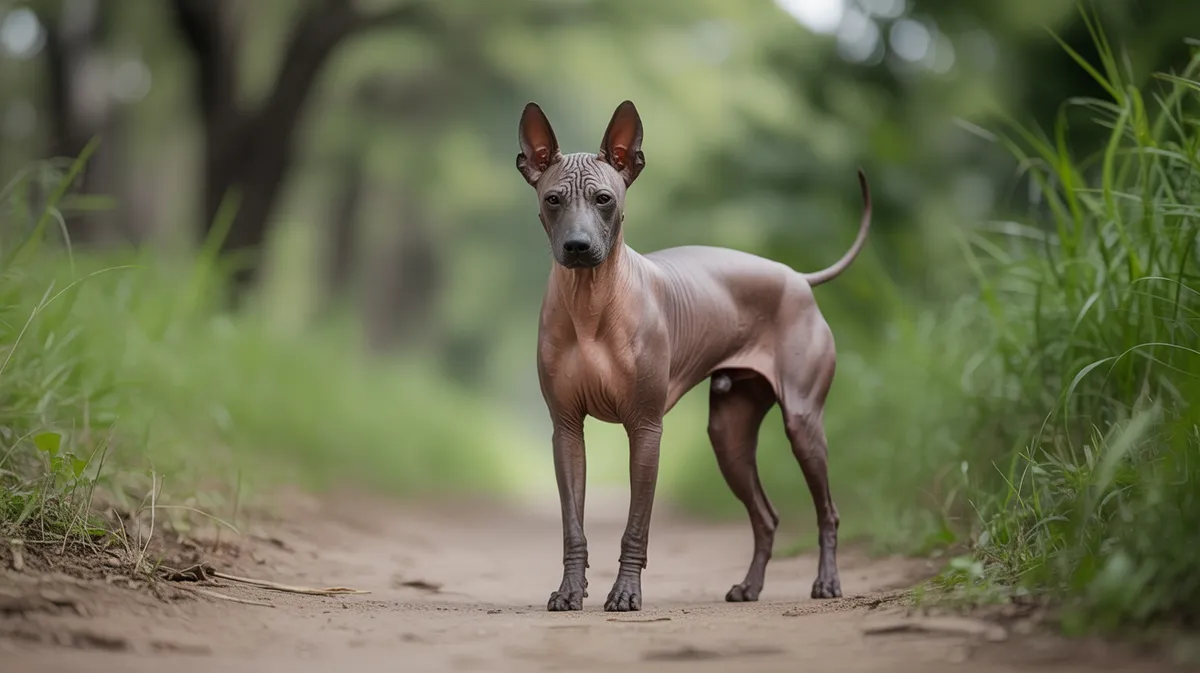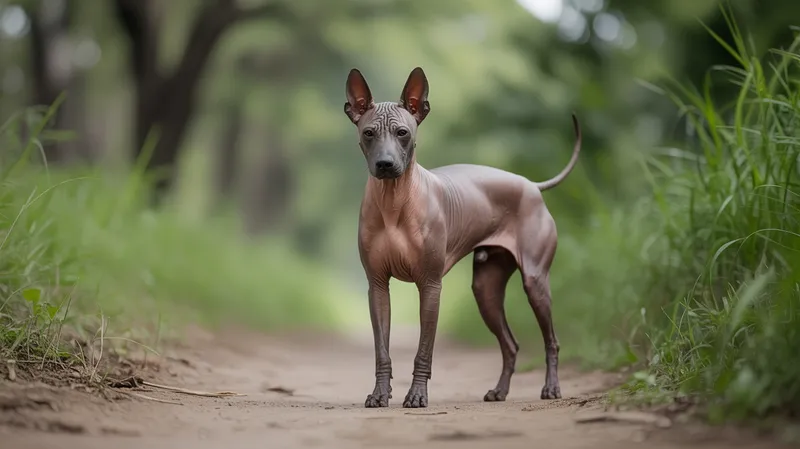
Mexican Hairless Dog
Canis lupus familiaris

Meet the Mexican Hairless Dog
The Xoloitzcuintli, often called the Mexican Hairless Dog, is an ancient dog breed native to Mexico, revered for its unique appearance and cultural significance. Most individuals are hairless, displaying smooth, tough skin, though a coated variety also exists. Xolos come in three sizes: toy, miniature, and standard, and are known for their loyal, calm demeanor. Historically, they were considered sacred by the Aztecs and believed to have spiritual and healing powers.
Classification
Mammal
Habitat
Human settlements, urban and rural areas, temperate and tropical regions
Diet
Omnivore
Lifespan
13-18 years
Conservation
Least Concern
Weight
4-25 kg (9-55 lbs)
📖Fascinating Facts
Ancient Heritage
Archaeological evidence of Xoloitzcuintlis dates back to pre-Columbian times, showing their presence in ancient tombs and artifacts.
Hypoallergenic Coat
The hairless variety produces little to no dander, making it a good choice for some people with dog allergies.
Sacred Status
The Aztecs, Toltecs, and Maya all considered the Xoloitzcuintli sacred, and the breed often featured in their religious ceremonies and mythology.
📋Detailed Description
The Mexican Hairless Dog, or Xoloitzcuintli, is a highly distinctive breed characterized by its mostly hairless body, though a coated variant exists. The breed comes in three size categories: standard (46–60 cm at the shoulder, 18–23.5 in), miniature (36–45 cm, 14–18 in), and toy (23–35 cm, 9–14 in), with weights ranging from 4 to 25 kg (9–55 lbs) depending on size. The skin is typically tough, smooth, and can be black, slate, bronze, or reddish, often with sparse hair on the head, tail, and feet. Xolos have a lean, muscular build, erect ears, and almond-shaped eyes, contributing to their alert expression. Dental anomalies are common, especially in the hairless variety, often resulting in missing premolars due to the same genetic mutation responsible for hairlessness. Behaviorally, Xolos are calm, intelligent, and highly loyal, forming strong bonds with their families and displaying a reserved demeanor with strangers. They are known for being quiet and vigilant, making them excellent watchdogs. Socially, they are adaptable, coexisting well with other dogs and pets when properly socialized. Reproductively, both coated and hairless pups can occur in the same litter, with the hairless trait being a dominant, but homozygous lethal, gene. Xolos have a lifespan of 13–18 years and are generally robust, though their exposed skin requires protection from sun and injury. Their unique physiology includes a higher skin temperature, which has contributed to their traditional use as 'healing' dogs in Mexican culture.
💡 Did you know?
The Xoloitzcuintli was named after Xolotl, the Aztec god of lightning and death, and was traditionally believed to guide souls to the underworld.
🔬Research & Sources
Wikipedia Summary
The Xoloitzcuintle is one of several breeds of hairless dog. It is found in standard, intermediate, and miniature sizes. The Xolo also comes in a coated variety, totally covered in fur. Coated and hairless can be born in the same litter as a result of the same combination of genes. The hairless variant is known as the Perro pelón mexicano or Mexican hairless dog. It is characterized by its wrinkles and dental abnormalities. In Nahuatl, from which its name originates, it is xōlōitzcuintli (singular) and xōlōitzcuintin (plural). The name comes from the god Xolotl that, according to ancient narratives, is its creator and itzcuīntli, meaning 'dog' in the Nahuatl language.
Last Modified: 6/1/2025
🎭Behavior & Social Structure
Xoloitzcuintlis are known for their calm, attentive, and intelligent disposition. They are typically quiet, barking only when necessary, and are highly sensitive to their owners' moods and routines. Xolos are diurnal, being most active during the day and resting at night, often seeking warmth by burrowing under blankets or lying in sunlit areas. Their feeding behavior is omnivorous, but they require a balanced diet with high-quality protein and fat due to their lean musculature. Xolos are not natural hunters, but their alertness and agility make them good at detecting intruders or unusual activity. Socially, they thrive in close-knit family groups, showing strong attachment to their primary caregivers. They are generally tolerant of other pets, especially if raised together, but can be reserved or aloof with unfamiliar animals or people. Playful and energetic, especially in youth, Xolos require regular exercise and mental stimulation to prevent boredom-related behaviors.
👶Reproduction & Life Cycle
Xoloitzcuintlis reach sexual maturity between 8 and 12 months of age. The breed is monoestrous, with females coming into heat typically twice a year. Mating is natural, and both coated and hairless puppies can be produced in the same litter due to the dominant inheritance of the hairless gene (FOXI3 mutation). The gestation period averages 63 days. Litter sizes range from 3 to 7 puppies. Parental care is strong; mothers are attentive, and puppies are born blind and helpless, requiring warmth and protection. The hairless puppies are particularly sensitive to temperature and skin injury in the neonatal period. Breeding is carefully managed to avoid homozygous hairless combinations, which are embryonically lethal. Responsible breeders screen for health and temperament, and early socialization is crucial for well-adjusted adults.
🛡️Adaptations & Survival
The most notable adaptation of the Xoloitzcuintli is its hairlessness, which is the result of a dominant genetic mutation affecting the FOXI3 gene. This adaptation reduces the risk of external parasites such as fleas and ticks and makes the breed well-suited to warm climates. The breed's skin is thick and tough, providing some protection against minor injuries and sun exposure, though they remain susceptible to sunburn and require skin care. Their higher skin temperature is a physiological adaptation that has led to their traditional use as 'heating pads' for people with joint pain or illness. Behaviorally, Xolos are highly adaptable, able to thrive in both rural and urban environments, and their reserved, quiet nature makes them suitable for indoor living. Their keen senses and alertness are evolutionary traits retained from their ancient ancestry as watchdogs and companions.
📚Research Sources
🎨Cultural Significance
The Xoloitzcuintli holds profound cultural and spiritual significance in Mexico. Revered by the Aztecs, Toltecs, Maya, and other indigenous peoples, Xolos were believed to guide souls to the afterlife and were often buried alongside their owners. The breed is named after the Aztec god Xolotl, the deity of lightning and death, and 'itzcuintli,' meaning dog in Nahuatl. Xolos were also considered to have healing properties, with their warm skin used to alleviate ailments such as arthritis and insomnia. They appear in ancient art, pottery, and mythology, and are still featured in Day of the Dead celebrations. The Xoloitzcuintli is recognized as the national dog of Mexico and is a living symbol of indigenous heritage and resilience.
🔬Recent Research & Discoveries
Recent genetic studies have identified the FOXI3 gene mutation as responsible for the hairless trait in Xolos, which is shared with other hairless breeds like the Chinese Crested. Ongoing research is focused on the breed's unique immune system, skin microbiome, and dental anomalies. Studies on the Xolo's role in ancient Mesoamerican societies have provided insights into pre-Columbian domestication and human-animal relationships. Conservation genetics projects are underway to ensure the breed's long-term viability and genetic health. Additionally, the Xolo is being studied for its hypoallergenic properties and potential as a model for understanding certain human skin conditions.
🎥Wildlife Videos

This Ugly-Cute Hairless Dog Has a Surprising History | Nat Geo Wild
About National Geographic Wild: National Geographic Wild is a place for all things animals and for animal-lovers alike. Take a ...
Nat Geo Animals

Xoloitzcuintle 🐶 One Of The Rarest Dog Breeds In The World | 1 Minute Animals
The Xoloitzcuintle, also known as the Mexican Hairless Dog, has a rich cultural and spiritual history in Mexico. It was believed to ...
1 Minute Animals

ALL ABOUT LIVING WITH XOLOITZCUINTLI
The Xoloitzcuintli dog breed — sometimes called the Mexican Hairless or just Xolo — may well have descended from the first ...
Dogumentary TV

ALL ABOUT XOLOITZCUINTLI: THE MEXICAN HAIRLESS DOG
Please support the Channel by checking out my affiliate links!!! Become a Dogumentary TV Channel member!!!
Dogumentary TV

THE XOLO DOG - SCARY OR BEAUTIFUL? - Mexican Hairless Xoloitzcuintli
Anneka meets Milo and Sapphira, mystical, otherworldly looking dogs called a XOLO, revered by the Mayans and Mexicans for ...
Animal Watch

Is This Really an Ancient Dog Created by Gods? | Mexican Hairless Dog
Over 3000 years ago, who would've thought that one ancient breed of canines would survive the test of time and become a perfect ...
Blue Orangutan
🌍Habitat Information
The Mexican Hairless Dog typically inhabits Human settlements, urban and rural areas, temperate and tropical regions environments. Mexican Hairless Dogs have adapted to their environments with specialized features and behaviors.
Primary Habitat:
Human settlements, urban and rural areas, temperate and tropical regions
More detailed habitat information will be available soon.
🛡️Conservation Status
The Mexican Hairless Dog is currently classified as Least Concern. Conservation efforts are crucial for preserving this species for future generations.
Common Threats:
- 🏠Habitat loss and fragmentation
- 🌡️Climate change impacts
- 🎯Hunting and poaching
- 🏭Human-wildlife conflict
⚠️Threats & Conservation Challenges
Currently, the Xoloitzcuintli is not considered threatened and enjoys a stable population, particularly due to its status as a national symbol of Mexico and its increasing popularity as a companion animal. However, the breed has faced historical challenges, including near-extinction during the 20th century due to changing cultural attitudes and the introduction of foreign dog breeds. Modern threats include irresponsible breeding, genetic bottlenecks, and skin health issues related to hairlessness. Urbanization and loss of traditional rural lifestyles have also impacted the breed's cultural role. Conservation efforts by breed clubs and the Mexican government have helped stabilize and promote the breed, but ongoing vigilance is needed to maintain genetic diversity and health.
🔬Scientific Classification
Scientific Name
Canis lupus familiaris
Classification Hierarchy
🔍 About Taxonomic Classification
Taxonomic classification is a hierarchical system used by scientists to classify and organize living organisms based on shared characteristics and evolutionary relationships.
The system moves from broad categories (Kingdom) to increasingly specific ones, with each animal's scientific name typically consisting of its Genus and species.
📝Community Notes
Share your observations and insights about the Mexican Hairless Dog with our community of wildlife enthusiasts.
Join Our Community
Sign in to share your observations and connect with fellow wildlife enthusiasts.
Sign In to ContributeNo community notes yet
Be the first to share your observations about the Mexican Hairless Dog!
Explore Mexican Hairless Dog
Select a tab above to learn more about this amazing animal.
📸Photo Gallery
No photos available for this animal yet.
🌟Discover More Wildlife
Continue your journey of discovery with more fascinating animals from our database
